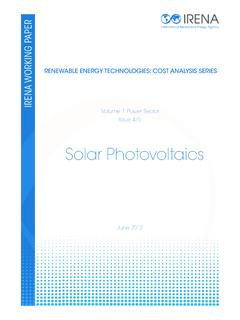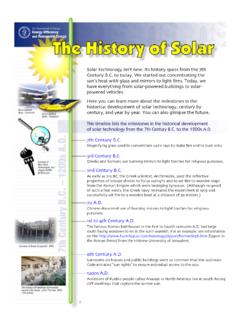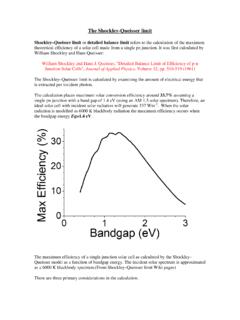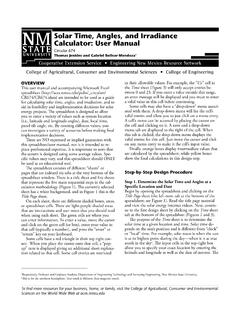Transcription of How a Photovoltaic Cell Works From Silicon to Electricity
1 2011 The NEED Project Box 10101, Manassas, VA 20108 43 How a Photovoltaic Cell Works Step 1A slab (or wafer) of pure Silicon is used to make a PV cell. The top of the slab is very thinly diffused with an n dopant such as phosphorous. On the base of the slab a small amount of a p dopant, typically boron, is diffused. The boron side of the slab is 1,000 times thicker than the phosphorous side. Dopants are similar in atomic structure to the primary material. The phosphorous has one more electron in its outer shell than Silicon , and the boron has one less. These dopants help create the electric field that motivates the energetic electrons out of the cell created when light strikes the PV phosphorous gives the wafer of Silicon an excess of free electrons; it has a negative character.
2 This is called the n-type Silicon (n = negative). The n-type Silicon is not charged it has an equal number of protons and electrons but some of the electrons are not held tightly to the atoms. They are free to move to different locations within the boron gives the base of the Silicon a positive character, because it has a tendency to attract electrons. The base of the Silicon is called p-type Silicon (p = positive). The p-type Silicon has an equal number of protons and electrons; it has a positive character but not a positive charge. Step 2 Where the n-type Silicon and p-type Silicon meet, free electrons from the n-layer flow into the p-layer for a split second, then form a barrier to prevent more electrons from moving between the two sides.
3 This point of contact and barrier is called the p-n both sides of the Silicon slab are doped, there is a negative charge in the p-type section of the junction and a positive charge in the n-type section of the junction due to movement of the electrons and holes at the junction of the two types of materials. This imbalance in electrical charge at the p-n junction produces an electric field between the p-type and n-type Silicon . Step 3If the PV cell is placed in the sun, photons of light strike the electrons in the p-n junction and energize them, knocking them free of their atoms. These electrons are attracted to the positive charge in the n-type Silicon and repelled by the negative charge in the p-type Silicon .
4 Most photon-electron collisions actually occur in the Silicon base. Step 4A conducting wire connects the p-type Silicon to an electrical load, such as a light or battery, and then back to the n-type Silicon , forming a complete circuit. As the free electrons are pushed into the n-type Silicon they repel each other because they are of like charge. The wire provides a path for the electrons to move away from each other. This flow of electrons is an electric current that travels through the circuit from the n-type to the p-type addition to the semi-conducting materials, solar cells consist of a top metallic grid or other electrical contact to collect electrons from the semi-conductor and transfer them to the external load.
5 And a back contact layer to complete the electrical siliconp-type siliconNEGATIVE CHARACTERPOSITIVE CHARACTER electric fieldPOSITIVE CHARGENEGATIVE CHARGEn-typep-typep-n junctionA location that can accept an electronProtonTightly-held electronFree electronFrom Silicon to ElectricitySTEP 1 STEP 2 FREE ELECTRON loadelectric fieldsunSUNSTEP 4electric fieldPHOTONSn-typep-typep-n junctionPOSITIVE CHARGENEGATIVE CHARGESUNSTEP 3 Photovoltaic cells








